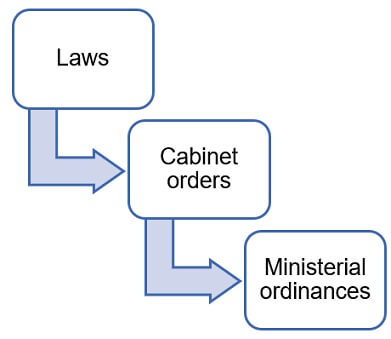[Chapter 4] Section 1 Laws and Regulations and Public Notice
1. Japanese Legal System
The Constitution of Japan exists to guide the nation and its people along the “right path”. Various laws have been established to realize the Constitution.

Law:
Stipulates the legal codes and
basic contents to be enacted by the Diet
Cabinet Order:
Supplements to orders for the enforcement of acts enacted
by the Cabinet, classifications of standards prepared
Ministerial Ordinance:
Established by Ministers.
Rules that provide specific standards.
Laws and regulations:
General term for laws, orders, and ordinances.
Public notice:
Established by ministers. Announcement of mainly technical contents.
Notification:
Directives issued by higher-level government agencies to lower-level government agencies. Includes matters related to the interpretation of laws and regulations, operational policies, and instructions on safety and health training.
2. How to read the provisions of laws and regulations
・Articles are called 条(Jo) Japanese.
Sometimes, articles are also written as Article XX-2.
・Paragraphs or clauses are called 項 (Ko) in Japanese.
Normally, the first paragraph is not numbered and the “1” is omitted.
・号(Go) are numbers indicating the order in which subdivisions are listed.
The parenthesis “()” in provisions show exclusions or supplementary explanations, so they are skipped here.
3. Industrial Safety and Health related laws and regulations
The Industrial Safety and Health Act was enacted in 1972 as a separate and independent chapter from Chapter 5 “Safety and Health” of the Labor Standards Act, which came into effect in 1947that same year. Therefore, there are provisions related to juveniles and women in a different chapter in the Labor Standards Act.
Consequently, occupational safety and health should not be governed by the Industrial Safety and Health Act alone, but together with the Labor Standards Act.
Caution! Industrial Safety and Health related laws and regulations also called “mandatory laws”
To begin with, the law does not recognize ” ignorance(I didn’t know that)”. If a person did not know something, he or she is judged to be at fault for not knowing.
Furthermore, mandatory laws are laws that are compulsorily applied regardless of whether the parties involved agree to them or not. In other words, even if a worker says, “I am used to working in high places, so I will not use fall prevention equipment since this work won’t take long,” the employer is not obliged to say, “Oh, okay, you be careful.”
Another characteristic of Industrial Safety and Health related laws and regulations is; unlike the Road Traffic Act where because there exists a “victim”, the “offender” is charged, the “business operator,” “supervisor,” or “worker” may be charged even if there is no “victim (victim)” if there is a violation of the law. (Breach of legal duty to take action)
Unique expressions in laws and regulations
For example, there is a provision which says; “If it is difficult to provide a work floor in accordance with the preceding paragraph, the business operator must take measures to protect workers from danger involving falls, such as putting up protective netting, and requiring workers to use fall prevention equipment meeting the required performance.” (Article 518, Paragraph (2))
Misunderstanding the “,” in “putting up protective, and requiring ….” may result in incorrect actions.
In this case, the “,” means “either putting up the netting” or “requiring workers to use fall prevention equipment” is sufficient (and not in violation of the law).
Industrial Safety and Health laws and regulations stipulate recurrence prevention
Suppose many people fall through openings. To falls crashes, laws and regulations stipulate that handrails be provided at openings. However, even if handrails are installed, there are still people who fall. Therefore, the laws and regulations will further require that the height of handrails be above XX cm. If the handrails are raised, there are people who may fall from under the handrails. If this happens, additional regulations will yet be enforced to prevent recurrence, such as “handrails at opening must be two rows.” In other words, the more detailed the regulations become, it means that the frequency of accidents is high, and the risk of danger increases if the laws and regulations are not followed.
地域・講習・人数に合わせてすぐに予約可能
講習会を予約する受講者様のご希望に合わせ、以下のタイプの講習会もご用意しています

このページをシェアする
講習会をお探しですか?